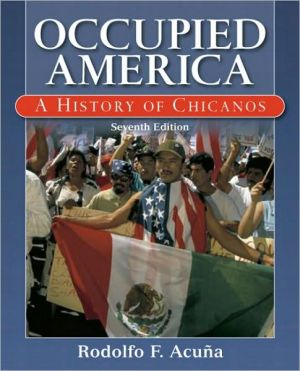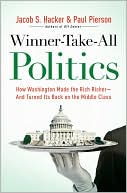Occupied America: A History of Chicanos
Authored by one of the most influential and highly-regarded voices of Chicano history and ethnic studies, Occupied America is the most definitive introduction to Chicano history. This comprehensive overview of Chicano history is passionately written and extensively researched. With a concise and engaged narrative, and timelines that give students a context for pivotal events in Chicano history, Occupied America illuminates the struggles and decisions that frame Chicano identity today.
Search in google:
Occupied America, designed to accommodate the growing number of Mexican-American or Chicano History courses, is the most comprehensive text in this market. The Sixth Edition of Occupied America has been revised to make the text more user-friendly and student-oriented, while maintaining its passionate voice.
Preface xviNot Just Pyramids, Explorers, and Heroes 1The Cradles of Civilization 2The Corn People 2The Olmeca 1500 BC-500 BC 3The Maya 5Maya Hieroglyphic Writing 6Maya Society 6The Decline of Mayan Civilization 7Teotihuacan 8Urbanism and Trade 8Other Corn Civilizations 9The Tolteca 10The Tarasco 10The Azteca 11En El Norte 13Conclusion: The World System in 1519 15The Core Zones 15The Semi-Peripheral Zones 16The Mesoamerican Periphery 16The Occupation of Middle America 17Africa Begins at the Pyrenees 17The Spanish Conquest 18Faith Versus Rationality 19The Spanish Invasion of the Mexica 19The Colonization of Native Mesoamerica 20Smallpox and Other Plagues 20The Conquest of Race and Labor in Mesoamerica 20Women in Colonial Mesoamerica 22The ChangingRoles of Women 22The Assimilation of Native Women 23Al Norte: God, Gold, Glory, Silver, and Slaves 25The Decline of the Indigenous Population 25The Changing Order 26The Bonanzas 27Forced Labor 27The Northern Corridor 28The Decline of the Native Population 29The Colonization of Texas 30El Paso del Norte 30The Tlaxcalan and the Castas 31The Importance of San Antonio and Links to the Rio Bravo 31The Occupation of Alta California: Paradise Lost 32Los Indios 32The Missions: Myth and Reality 33Conclusion: On the Eve of the Mexican War of Independence 33A Legacy of Hate: The Conquest of Mexico's Northwest 35Mexican Independence from Spain 35The Colonial Legacy 36The Nation-State 36Background to the Invasion of Texas 36Broken Promises 37Causes of the War 37Follow the Money: The Land Companies and Trade 38Wanna-Be Sam Adamses 38The Point of No Return 39The Invasion of Texas 39The Pretext: Myths of the Alamo 40The Defense of the Mexican Homeland 40Mexicans Win the Battles but Lose the War 41The Invasion of Mexico 42The Manufactured War 42An Unwarranted Aggression 43The Pretext for Conquest 43Religious Justifications for War 43History as Propaganda 44The Myth of a Nonviolent Nation 44Peacemakers Expose the Violence of War 45The San Patricio Battalion 46The War Crimes 46Mexicans on the Front Lines 47The Prosecution of the War 47The Treaty of Guadalupe Hidalgo 48The Controversy 48The Deception 49The Honorable Man 50Conclusion 50Remember the Alamo: The Colonization of Texas 52The Years Between 1836 and 1845 53To the Victor Belong the Spoils 53The Border 54The Founding Fathers? 55The Robber Barons Become Captains of Industry 56Social and Political Ostracization and Control 57The Consolidation of Texas Wealth 58Socialization 59The Indian Savage, the Mexican Bandit 59Controlling the Mexicans 59Politics of Race and Gender 61The Resistance 62Runaway Slaves 63Trade Wars 63Social Banditry 64The Case of Juan Cortina 64The People's Revolt 66The Ballad of Gregorio Cortez 66The Transformation 67The Restructuring 67The Railroad and the Advent of Industrial Capitalism 67Mexico Comes to Texas 68Reform Politics and Mexicans 69The Growth of the Mexican Population 69The Growth of Racist Nativism 69Mexican Resistance 70Conclusion 71Freedom in a Cage: The Colonization of New Mexico 73On the Frontier 73The Santa Fe Trail: The Trojan Horse 74Anti-American Sentiment 75The Euroamerican Invasion 75The Taos Revolt 75Inventing Tradition 76The Transition 77The Illusion of Inclusion 78Gringos and Ricos 78How Was It Done? 79The Santa Fe Ring and the Land Grab 80The Lincoln County War 81Socialization 83The Americanization of the Catholic Church 83The New Mexican Diaspora 84It's the Chili 84New Mexico in Colorado 85The Resistance 85The Land Grabbers 86The Village People Defend Their Land 86More Illusions of Inclusion 87The End of the Frontier 88The Growth of Industrial Mining 88Changes in Society 89Federal Encroachment 89Conclusion 90Sonora Invaded: The Occupation of Arizona 91The Frontier 92The Gadsden Purchase 92The Silent War with Sonora 93Filibustering Expeditions into Sonora 93Mexicans in Early Arizona 94Tensions 94"All animals are equal, but some animals are more equal than others." 95Marrying Up! 95The Alliance of Elites 96The War Against the Apache 97The Fate of the "Friendly Indian" 97The Land-Grab Grant 97The Transformation of Arizona 98From Adobe to Copper 98Border Conflicts 99The Industrialization of Arizona 99The Importance of Mining 99The Expansion of Capital 100Industrial Mining 100The 1890s: The De-Skilling of Mine Work 101The Pull Factor 101The Impact of Industrialization on Mexicans 101Mutual Aid Societies 102The Mexican Middle Class 102Small Favors to Women 103Miners Organize: The Emergence of Trade Unions 103It's the Water 103Conclusion 104California Lost: America for Euroamericans 106Indians Count 106The Spanish Occupation 107The Mexican Period 108The Gap Between Classes 108No Utopia! Women and the Transformation of California 109The Bear Flag 109John C. Fremont and the Bear Flag 110U.S. Invasion of California 110Gold Transforms California 111The Gold Rush Creates a Template 111Complicity of the Californios 111Legalized Theft: The Foreign Miners' Tax 112Decline of the Californios 112The Locusts 113Taxation Without Representation 113Marrying White 114The Whitening of California 114Legitimization of Violence 115The Mexican Prostitute 115The American Dream, The Lugos Trial 116The Disillusionment 117El Clamor Publico 117Class Divisions 119Social Banditry 120Tiburcio Vasquez 120Mexicans in a Changing Society 121Becoming a Minority 122The Church's Role 122Labor 123The Exclusion of the Other 123Colonias 123Conclusion 124Immigration, Labor, and Generational Change 126Overview 126The Transformation 127The Push 127The Pull 128Opposition to Diaz 129The Pinos Altos Strike 129Precursors to Revolution 129The Triangle 130Teresa de Urrea 132Disciplining Mexicans: Forty Blonde Babies 132The Mexican Diaspora 132Exploitation Begets Resistance 133The Struggle for Equal Education 134The Mexican Revolution 135A Changing Society 137Mexican Workers Under Siege 137Pancho Villa Drives the Gringos Crazy 139The Hysteria: The Plan of San Diego 140World War I: The Big Shift 141Shifts in Political Consciousness 141Mexican Responses to Industrial Transformation 142The Failure of American Brotherhood 143The Westward Movement of King Cotton 143Conclusion 144The 1920s: The Effects of World War I 145Americanization: A Study of Extremes 145Protestant Churches and Americanization of the Mexican 147Catholic Churches React to Americanization 147Nationalism Versus Americanization 148Mexicans and Mexican Americans 148The Influence of World War I on Becoming Mexican American 149The League of United Latin American Citizens 150The Move to the Cities 152San Antonio's West Side 152Los Angeles: "Where Only the Weeds Grow" 153Mexicans in the Midwest and Points East 156Mexican Labor in the 1920s 158Importance of the Sugar-Beet Industry 159Mexicans in the Northwest 160Mexicans in Texas 161Mexicans in the Midwest 161The Growth of California Agribusiness 162Mexican Unions 162Greasers Go Home 164Keeping America Blond and White 164Conclusion 166Mexican American Communities in the Making: The Depression Years 167The Great Depression: La Crisis 168Stresses and Strains During La Crisis 169Life During the Great Depression 169The Importance of Being San Antonio 172Nativist Deportations of the 1930s 173Repatriation Texas-Style 174The Fate of the Deportee in Mexico 174Factories in the Fields 175Texas Farms 175Renting Mexicans 176The Farm Workers' Revolt 176The El Monte Strike 177The Tagus Ranch 178The San Joaquin Valley Cotton Strike 178The Imperial Valley, 1934 180CUCOM and Mexican Strikes 180The Congress of Industrial Organizations 181Rural Workers in the Lone Star State 182Colorado and the Manitos 183The City 184Los Angeles Mexican Women Garment Workers 184San Antonio Mexicana Workers 185La Pasionaria, the Pecan Shellers' Strike, and San Antonio 186Unionization in Los Angeles 187Labor in the Midwest: Chicago 188The Mexican American Miners' Revolt 189The Mexican-Origin Community 190The Los Angeles Community 191The Mexican American Movement 192El Congreso de los Pueblos de Habla Espanol 192Fighting Segregation 193The Manitos 194Move to the Windy City: Chicago 195Conclusion 195World War II: The Betrayal of Promises 197Changing Identities 197World War II and the Mexican 198El Soldado Raso 198The Case of Guy Gabaldon 199The Story of Company E: The All-Mexican Unit 199Racism at Home and Abroad 200Chicanas Go to War 200The Home Front 201A Profile of Courage 201Finding Scapegoats 201The Sleepy Lagoon Trial 202Mutiny in the Streets of Los Angeles 204Mexicanas Support the War Effort 205Rosita the Riveter 206The Federal Employment Practices Commission 207The Making of the Cold War: The Politics of Control 209Control of Labor 209The Communists Are Coming 210Postwar Opportunities 210Toward a Civil Rights Agenda 212The American G.I. Forum 212A Transitional Period 213Police and Institutional Brutality 213Controlling Mexican Labor 215The Return of Farm Labor Militancy 215Importing Mexicans 217Conclusion 219"Happy Days": Chicano Communities Under Siege 221The Cold War 222The Korean War: Historical Amnesia 222Keeping America American 223Militarization of the Immigration and Naturalization Service 225The Diaspora: An American Odyssey 226The Cities 227Seduced by the Game 230New Mexico: The Illusion of It All 330Los Angeles 231San Antonio 233El Paso 233Civil Rights 234The "Salt of the Earth" 234Toward Equality 235California 236National Spanish-Speaking Council 237The Struggle to Preserve the Barrios 237The FHA Mortgage-Loan and the G.I. Bill 238Urban Renewal: The Day of the Bulldozer 238The Dodgers and Chavez Ravine 239Gentrification in the Midwest 240Conclusion: The Importance of 1959 241Goodbye, America: The Chicano in the 1960s 242The Early 1960s 243Inequality 243Harvest of Shame 245High Hopes: Illusions of the Sleeping Giant 246San Antonio 246Los Angeles 247Organizing in Chicago 248The Building of a Civil Rights Coalition 248Viva Johnson 249Building the Great Society 249The Walkout 250The Black-White Syndrome 250The Illusion Fades 251Impact of the War on Poverty 252Magnetization of the Border 252The Immigration Act of 1965 253Mexican American Reaction to the Memories of Nativism 253The Road to Delano 254Echoes of Delano 255The Road to Brown Power 256The Making of a Movement 257The Formation of Core Groups 258The East L.A. Walkouts 258Chicana/o Student Militancy Spreads 260The Brown Berets 260Tlatelolco, Mexico 261"Wild tribes of...the inner mountains of Mexico" 261Gringos and Tejanos 262The Land Struggle 263The Crusade for Justice 264Chicanas Speak! 265Other Voices 266The Chicano Youth Movement Gains Steam 266Where Is God? 267Violence at Home 267Chicanas/os Under Siege 268Conclusion 270The 1970s and 1980s: The Deconstruction of the Sixties 271Redefining Racism 273Government Legitimizes Racism 273The Politics of Cynicism: Nixon's Hispanic Strategy 273Dismantling the War on Poverty 274Chicano Power 274La Raza Unida Party 275Failure to Build a National Third Party 276The Last Days of La Raza Unida 277Inequality from Within 277Chicana Voices 277Inevitable Factions 278Las Hermanas 279Sterilization 280The Road to Delano 281The Farah Strike: The Breaking of Labor 281Sin Fronteras 282Nativism Is Racism 282Centro de Accion Social Autonoma-Hermandad de General de Trabajadores 283Get the Mexican Bandits 283The Media Perpetuates Racist Nativism 284Getting Away with Terrorism 284In Defense of the Foreign Born 285The Growth of the Chicano Middle Class 285Chicanos as Commodities 286Redefinition of the Political Middle 286Political Gains 287Education: the Stairway to the American Dream 288Education Equality 289Importance of the EOPs 289Expanding Political Vocabularies 290The "Pochoization" of the Vocabulary 291The Myth of a Color-Blind Society 291Legacy Admits 292Why Progressive Organizations Fail 292Violence as an Instrument of Control 293Conclusion 293Becoming a National Minority: 1980-2001 295The Tyranny of Words and Actions 295Shared Space 296El Salvador 297Nicaragua 297Guatemala 298Mexico 298Manufacturing the Crisis 298The Militarization of the Border 299Organizing Immigrant Workers 299The Hotel and Restaurant Workers 300The Janitors 300From Autos to Buses 301The Miners 301Boycott Levis-and Dockers, Too! 302Cesar Chavez and the UFW 302The Movement for Inclusion 303The Sleeping Giant 304Texas: The Lone Star 304Chicago: Where the Wind Blows 305New Mexico: The Illusion 306Colorado 306The Glass Ceiling 307A Profile of Chicanas 307Bucking the Glass Ceiling 307The Tejana Gender Gap 308Immigrant Women Workers 309The 1990s: A Portrait of Inequality 310Can You Smell the Refried Beans? 310Tejano Population Boom 310California: Political Gains 311Under the Influence of the Illusion 311The North American Free Trade Agreement 312The Zapatistas 313"Don't Mourn, Organize!" 313The Political Refugees 314Forging Communities 314The Idealists 315The Backlash 315It Didn't Happen by Accident 316Proposition 187: The American Way 316Proposition 209 and the Color-Blind Society 317Proposition 227: If You Speak One Language, You're American 318The National Scene: Census 2000 318The Big Three 319The California Revolution 319Texas: Gringos Speaking Spanish 320Chicago 320The Northwest: The Spread of the Tortilla Curtain 321The Age of the Believers 322Unsettled Scores 322Conclusion 323Epilogue: Is Antonio Banderas a Chicano? 325Identity and Interests 326Where Are the Other Latinos? 328Not an Identifiable Minority 328Is There a Latino Identity? 330Identifiable Inequality 331Immigration 331The Search for Equality 332The Poor 334"Be all that you can be" 334What's in the Future? 334The Search for Inclusion 336Conclusion 336The Map Room 338Creating a Timeline 340Book Notes 341Index 399








